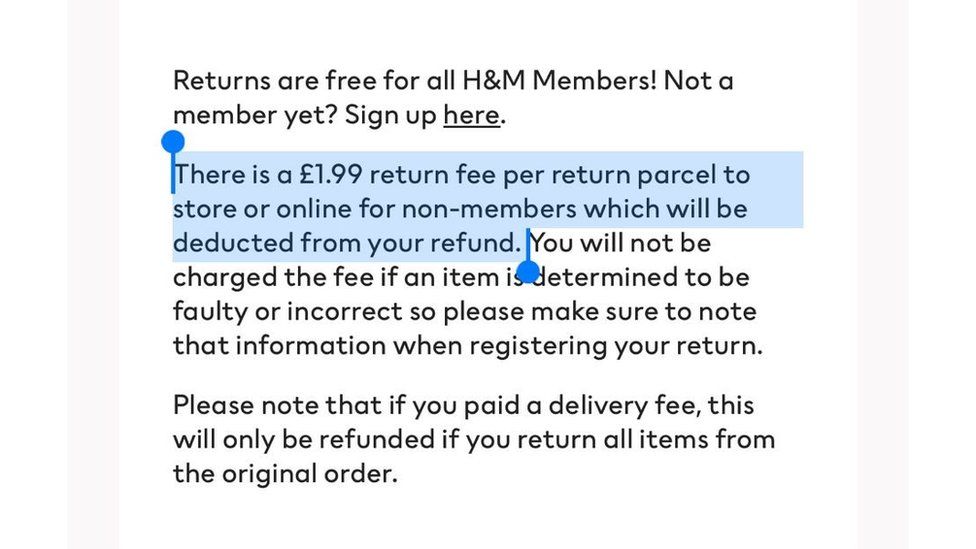In a strategic move echoing industry trends, fashion giant H&M has recently introduced a £1.99 fee for returning items purchased online. The company has joined a growing list of retailers, including Zara, Boohoo, Uniqlo, and Next, who have implemented similar charges for online returns.
While this development may raise eyebrows among shoppers, it reflects a broader shift in the retail landscape toward loyalty schemes, which have become essential in retaining customers amidst a cost-of-living crisis.
In this news feature, we will delve into the details of H&M’s new policy, its implications for both shoppers and retailers, and the evolving dynamics of customer loyalty.
The Return Fee: A Growing Retail Trend
Starting from this summer, H&M customers are now required to pay £1.99 when returning parcels either in-store or online, with the fee being deducted from the customer’s refund. However, it’s important to note that returns remain free for H&M members, underscoring the growing importance of loyalty programs in the retail sector.
What’s more, H&M’s decision to charge for returns reflects a trend sweeping across the retail industry. The surge in online shopping during the pandemic led to a significant increase in returned items, often due to sizing issues or unmet expectations.
However, retailers, traditionally footing the bill for online returns to attract customers, now find themselves seeking ways to offset these costs and streamline return processes.

Analysing the Economic Sense and Environmental Impact Considerations
Retail analysts suggest that other companies are likely to follow H&M’s lead in charging for returns, viewing it as a pragmatic approach. By implementing return fees, retailers can discourage the practice of bulk buying online and subsequently returning most of the items, a challenge that has plagued the industry for years.
While this shift may draw some negative reactions, it is hoped that most customers will understand the necessity behind such a decision.
What’s more, in a time of increasing environmental consciousness, consumers are becoming more aware of the ecological consequences of frequent deliveries and returns. Charging for returns could potentially lead to fewer parcels in transit, reducing the carbon footprint associated with online shopping.
Rights and Protections for Consumers
It’s crucial to clarify consumers’ rights in this context, therefore it should be known that customers are entitled to a refund within 30 days of purchase if the goods are faulty and bought from a UK-based retailer.
However, in cases where customers have simply changed their minds, shops are not obligated to offer exchanges, unless the items were purchased online, in which case a 14-day return window is applicable.
Importantly, it should be known that online purchases often come with additional protection, and H&M explicitly states on its website that the £1.99 fee will not be charged if items are determined to be faulty or incorrect.
The Advantages to Online Return Charges
Charging for online returns offers several significant benefits for both retailers and the broader retail ecosystem. Firstly, it serves as a practical measure to discourage excessive and often frivolous returns, where customers engage in bulk purchasing with the intention of returning a majority of items.
By introducing a return fee, retailers can foster more responsible shopping behaviour, reducing the strain on logistics and warehousing operations. This, in turn, translates to cost savings and improved operational efficiency for businesses.
Additionally, charging for returns contributes to sustainability efforts by curbing the environmental impact associated with frequent product shipping and handling. Moreover, it allows retailers to allocate resources more effectively, redirecting them toward enhancing product quality, customer service, and loyalty programs.
Finally, in the context of the cost-of-living crisis and evolving consumer expectations, this strategic shift in return policies aligns with long-term economic sustainability and the need to provide shoppers with transparent and fair retail experiences.

Disadvantages to Charging for Returns
While charging for online returns presents certain advantages for retailers, it also comes with notable disadvantages. One key concern is that it may deter potential customers from making online purchases in the first place, especially those who are unsure about sizing or product quality. This could potentially stifle online sales growth and limit market reach.
Additionally, charging for returns may generate negative perceptions among shoppers, eroding trust and brand loyalty. Customers may hesitate to shop with retailers that impose return fees, fearing the financial repercussions of receiving faulty or ill-fitting items.
Moreover, there is a risk of alienating certain customer segments, particularly those with disabilities or mobility issues, who rely on the convenience of online shopping and returns. In such cases, return fees may be seen as discriminatory or exclusionary, sparking backlash and potential legal challenges. Striking a balance between mitigating return-related costs and maintaining a positive customer experience remains a complex challenge for retailers considering this policy shift.
The Role of Loyalty Schemes
The move by H&M also highlights a broader strategy adopted by retailers during the ongoing cost-of-living crisis.
Experts suggest that loyalty schemes, such as offering free returns to members, have become a pivotal tool in retaining customers. In an era where consumer loyalty is increasingly fickle, providing clear incentives is paramount to securing repeat business.

Conclusion
H&M’s introduction of a £1.99 fee for online returns underscores the shifting dynamics of the retail industry. As retailers seek to offset the costs associated with online returns and enhance customer loyalty in a competitive landscape, similar policies may become more widespread.
While some customers may resist this change, it aligns with broader trends in retail and environmental awareness. As the retail landscape continues to evolve, consumers can expect further innovations in loyalty programs and return policies, shaping the way they shop in the years to come.









